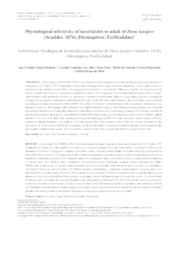Physiological selectivity of insecticides to adult of Doru luteipes (Scudder, 1876) (Dermaptera: Forficulidae).
Physiological selectivity of insecticides to adult of Doru luteipes (Scudder, 1876) (Dermaptera: Forficulidae).
Autoria: REDOAN, A. C. M.; CARVALHO, G. A.; CRUZ, I.; FIGUEIREDO, M. de L. C.; SILVA, R. B. da
Resumo: Doru luteipes (SCUDDER, 1876) is considered one of the best natural enemies of the fall armyworm Spodoptera frugiperda (J. E. Smith, 1797) (Lepidoptera: Noctuidae), feeding on their eggs and small caterpillars. For its conservation it is necessary to use selective insecticides to S. frugiperda and harmless to the predator. Therefore, objective of the present work was to evaluate the toxicity of insecticides registered to control of S. frugiperda. It was conducted bioassays with D. luteipes adults treated with insecticides directly by exposure to residues of compounds applied on glass plates and the consumption of eggs of S. frugiperda contaminated and offered each one, 24 and 48 hours after treatment. The insecticides were classified according to indices proposed by IOBC/WPRS. For adults D. luteipes treated directly with insecticides, triflumuron was harmless (class 1); chlorfenapyr and etofenprox as slightly harmful (class 2) teflubenzuron/?-cypermethrin and spinosad moderately harmful (class 3) and thiamethoxan/? -cyhalothrin harmful (class 4). In bioassay exposure of D. luteipes residues of insecticides applied to glass plates, all products were harmful to the predator, except triflumuron which was considered slightly harmful. The survival of adults after consumption of contaminated eggs was 46.7% for the insecticide tiametoxam/? -cialotrina considered slightly harmful to the predator. The other insecticides were innocuous. Due to the low toxicity presented by the triflumuron to the D. luteipes adults, this compound can be recommended in programs aimed at integrated pest management the preservation of this natural enemy. All other products must be evaluated in greenhouse and field to prove its toxicity.
Ano de publicação: 2013
Tipo de publicação: Artigo de periódico
Unidade: Embrapa Milho e Sorgo
Palavras-chave: Inseticida, Lagarta, Pesticida, Praga de planta, Toxidez
Observações
1 - Por padrão são exibidas publicações dos últimos 20 anos. Para encontrar publicações mais antigas, configure o filtro ano de publicação, colocando o ano a partir do qual você deseja encontrar publicações. O filtro está na coluna da esquerda na busca acima.
2 - Para ler algumas publicações da Embrapa (apenas as que estão em formato ePub), é necessário ter, no celular ou computador, um desses softwares gratuitos. Sistemas Android: Google Play Livros; IOS: iBooks; Windows e Linux: software Calibre.
Acesse outras publicações
Acesse a Base de Dados da Pesquisa Agropecuária (BDPA) para consultar o acervo completo das bibliotecas da Embrapa.

